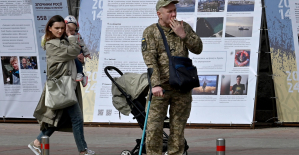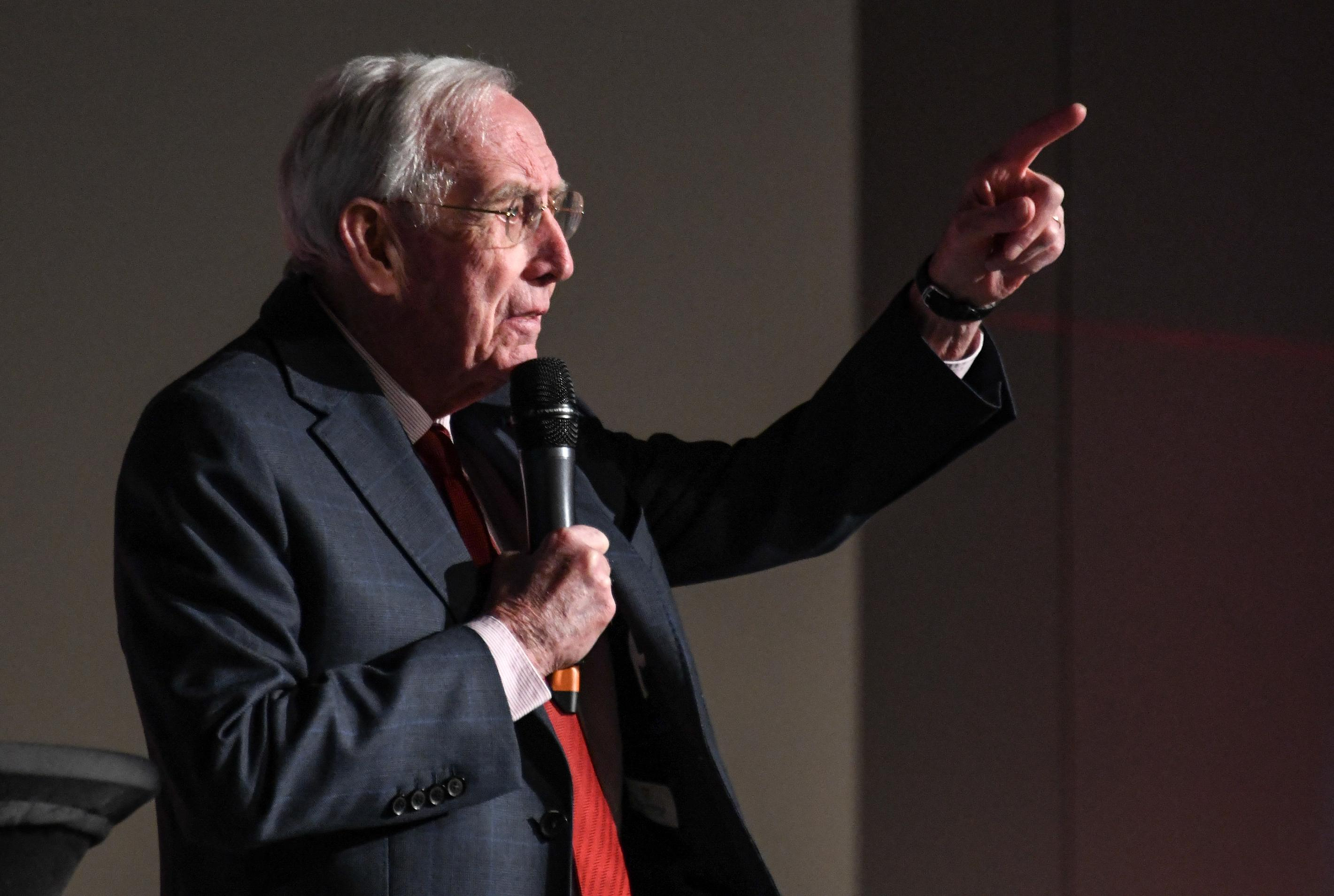Since the beginning of the war, the United States has been Ukraine's biggest supporter by far. However, that could change soon. For the first time, the European Union (EU), together with the member states, is about to overtake the Americans.
This emerges from the current issue of the Ukraine Support Tracker, which the Kiel Institute for the World Economy (IfW) uses to regularly analyze the financial, military and humanitarian aid for the country invaded by Russia.
As a result, Washington has so far sent around 48 billion euros to the Ukrainians, mostly in the form of arms shipments. In Europe, however, the total amount could soon rise to almost 52 billion euros thanks to new financial aid according to the IfW: At a public consultation of the EU finance ministers on Tuesday, the representative of Hungary voted against the release of new funds of 18 billion euros for Kyiv.
But the other finance ministers agreed on a circumvention strategy. The money is intended to secure the budget of the war-torn country in the coming months.
IfW economist Christoph Trebesch warns, without further financial aid, a catastrophe threatens: "Without external money, Ukraine would slide into hyperinflation, the population could no longer be supplied, millions are already freezing in the dark," says Trebesch, who together with his team regularly tries to measure other governments' pledges to Ukraine in euros and cents.
Compared to other crises, however, the expanded aid payments are still very manageable, says Trebesch. "If you compare the sums, for example with the 250 billion euros that were mobilized for Greece during the euro crisis, then we are still talking about small amounts when it comes to aid to Ukraine," says Trebesch.
According to IfW statistics, Germany has provided unilateral aid worth 5.4 billion euros since the invasion began in February - including all arms deliveries and other non-cash benefits. That sounds like a lot at first, and after all, Germany is even right behind the USA (48 billion euros), the entire EU (35 billion euros) and Great Britain (7.1 billion euros).
However: "That corresponds to only three percent of the recently decided double boom to support the German population in this crisis," Trebesch calculates. In December alone, the German state will take on gas and district heating bills worth nine billion euros.
German aid has a share of 0.14 percent in the gross domestic product. The support provided by the Eastern Europeans, above all the Baltic states and Poland, is significantly larger, which, measured in terms of economic output, delivers five to six times that of Germany and France, for example.
Guntram Wolff, director of the German Council on Foreign Relations (DGAP), warns against miscalculating aid to Ukraine: "If funding is not maintained, the government of Ukraine would eventually be forced to cut military spending. That would have an impact on the course of the war, and that cannot be in Europe's interest."
However, Wolff considers it remarkable that Europe could soon overtake the USA in the overall statistics due to larger financial aid: "This ends a narrative that everything is said to depend on the USA - which is also used domestically by the Republicans there."
In the current IfW Support Tracker issue, Germany has also moved up in the ranking of military aid - "also because of the high-quality and expensive Iris-T systems, although you have to consider that out of five promised systems only one was delivered", states Wolff.
With all aid, the IfW tries to distinguish between commitments and completed deliveries, which is not an easy task, especially in the USA, as Trebesch emphasizes. The federal government, on the other hand, now publishes the current status of the delivered military goods on a website.
The list clearly shows the enormous scope of the aid provided. Listed are the recently delivered Biber armored bridge laying vehicles, sleeping bags, ambulances, reconnaissance drones, but also the five multiple rocket launchers MARS II.
Germany, on the other hand, does not want to deliver battle tanks or armored personnel carriers, despite regular inquiries from Kyiv, and so the Federal Republic continues to rank among “also ran” in these categories: The USA sent 300 armored vehicles, Germany on the other hand only 80. Even Lithuania’s share with 89 vehicles is bigger.
Tanks have so far come from Slovakia and Poland, which provided large parts of their combat-ready stocks, which are now to be replenished with bulk orders from South Korea. The number of howitzers delivered from the USA is 108, and 14 came from Germany – which clearly surpasses even Norway with 22 devices.
However, DGAP Director Wolff emphasizes: “Mine clearance vehicles and the MARS rocket launchers also make an important contribution.” He now sees France’s role critically: “It is also remarkable that France is very far down in all IfW rankings. Against this background, it is astonishing that President Macron repeatedly puts himself in the foreground and thinks he can take on the role of a mediator," said Wolff.
In general, the aid, especially from Western Europeans, with the possible exception of Great Britain, was within a very manageable range, mostly well below 0.4 percent of gross domestic product: "That's little if you consider the historical dimensions of the war," says Wolff. "After all, it's about security, freedom and the economy throughout Europe."
This realization does not seem to have arrived in the defense budget of the Federal Republic. Despite the 100 billion euro special fund for the Bundeswehr, Germany will still miss NATO's two percent target in the coming years, according to a study by the German Economic Institute (IW).
According to the IW, the goal of spending two percent of economic output on defense is "a long way off, and procurements that are necessary in the short term are not making any progress either." The "Rheinische Post" first reported on the study. The regular defense budget must therefore be increased "by at least five percent" per year without adding the special fund in order to achieve the two percent target.
"Everything on shares" is the daily stock exchange shot from the WELT business editorial team. Every morning from 5 a.m. with the financial journalists from WELT. For stock market experts and beginners. Subscribe to the podcast on Spotify, Apple Podcast, Amazon Music and Deezer. Or directly via RSS feed.

 Poland, big winner of European enlargement
Poland, big winner of European enlargement In Israel, step-by-step negotiations for a ceasefire in the Gaza Strip
In Israel, step-by-step negotiations for a ceasefire in the Gaza Strip BBVA ADRs fall almost 2% on Wall Street
BBVA ADRs fall almost 2% on Wall Street Ukraine has lost 10 million inhabitants since 2001... and could lose as many by 2050
Ukraine has lost 10 million inhabitants since 2001... and could lose as many by 2050 Sánchez cancels his agenda and considers resigning: "I need to stop and reflect"
Sánchez cancels his agenda and considers resigning: "I need to stop and reflect" The Federal Committee of the PSOE interrupts the event to take to the streets with the militants
The Federal Committee of the PSOE interrupts the event to take to the streets with the militants Repsol: "We want to lead generative AI to guarantee its benefits and avoid risks"
Repsol: "We want to lead generative AI to guarantee its benefits and avoid risks" Osteoarthritis: an innovation to improve its management
Osteoarthritis: an innovation to improve its management Ukraine gets a spokesperson generated by artificial intelligence
Ukraine gets a spokesperson generated by artificial intelligence The French will take advantage of the May bridges to explore France
The French will take advantage of the May bridges to explore France Organic flour contaminated by a recalled toxic plant
Organic flour contaminated by a recalled toxic plant 2024 Olympics: Parisian garbage collectors have filed a strike notice
2024 Olympics: Parisian garbage collectors have filed a strike notice Death of Paul Auster: Actes Sud says he is “lucky” to have been his publisher in France
Death of Paul Auster: Actes Sud says he is “lucky” to have been his publisher in France Lang Lang, the most French of Chinese pianists
Lang Lang, the most French of Chinese pianists Author of the “New York Trilogy”, American novelist Paul Auster has died at the age of 77
Author of the “New York Trilogy”, American novelist Paul Auster has died at the age of 77 To the End of the World, The Stolen Painting, Border Line... Films to watch this week
To the End of the World, The Stolen Painting, Border Line... Films to watch this week Omoda 7, another Chinese car that could be manufactured in Spain
Omoda 7, another Chinese car that could be manufactured in Spain BYD chooses CA Auto Bank as financial partner in Spain
BYD chooses CA Auto Bank as financial partner in Spain Tesla and Baidu sign key agreement to boost development of autonomous driving
Tesla and Baidu sign key agreement to boost development of autonomous driving Skoda Kodiaq 2024: a 'beast' plug-in hybrid SUV
Skoda Kodiaq 2024: a 'beast' plug-in hybrid SUV The home mortgage firm rises 3.8% in February and the average interest moderates to 3.33%
The home mortgage firm rises 3.8% in February and the average interest moderates to 3.33% This is how housing prices have changed in Spain in the last decade
This is how housing prices have changed in Spain in the last decade The home mortgage firm drops 10% in January and interest soars to 3.46%
The home mortgage firm drops 10% in January and interest soars to 3.46% The jewel of the Rocío de Nagüeles urbanization: a dream villa in Marbella
The jewel of the Rocío de Nagüeles urbanization: a dream villa in Marbella Europeans: a senior official on the National Rally list
Europeans: a senior official on the National Rally list Blockade of Sciences Po: the right denounces a “drift”, the government charges the rebels
Blockade of Sciences Po: the right denounces a “drift”, the government charges the rebels Even on a mission for NATO, the Charles-de-Gaulle remains under French control, Lecornu responds to Mélenchon
Even on a mission for NATO, the Charles-de-Gaulle remains under French control, Lecornu responds to Mélenchon “Deadly Europe”, “economic decline”, immigration… What to remember from Emmanuel Macron’s speech at the Sorbonne
“Deadly Europe”, “economic decline”, immigration… What to remember from Emmanuel Macron’s speech at the Sorbonne These French cities that will boycott the World Cup in Qatar
These French cities that will boycott the World Cup in Qatar Top 14: Fijian hooker Narisia leaves Racing 92 and signs for Oyonnax
Top 14: Fijian hooker Narisia leaves Racing 92 and signs for Oyonnax Europa League: Jean-Louis Gasset is “wary” of Atalanta, an “atypical team”
Europa League: Jean-Louis Gasset is “wary” of Atalanta, an “atypical team” Europa League: “I don’t believe it…”, Gasset jokes about Aubameyang’s age
Europa League: “I don’t believe it…”, Gasset jokes about Aubameyang’s age Foot: Rupture of the cruciate ligaments for Sergino Dest (PSV), absent until 2025
Foot: Rupture of the cruciate ligaments for Sergino Dest (PSV), absent until 2025
















